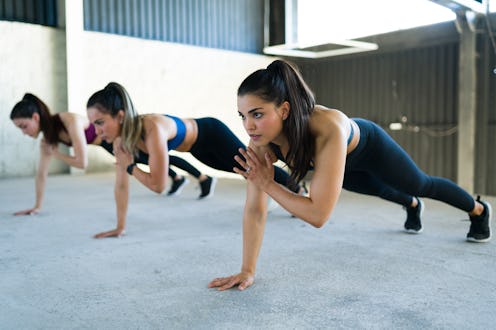Fitness
The Benefits Of Plank Shoulder Taps, According To Trainers
Plus, how to do it right.

TikTok’s left-right push-up challenge is viral for a reason. Not only is it set to a catchy song, it also features one of the best full-body exercises you can do: Plank shoulder taps.
Plank shoulder taps are a variation of a traditional plank with an added compound movement, says Teddy Savage, the head of health and fitness at Planet Fitness gyms. “When you suspend your body in a prone position, you’re keeping tension on your abs, low back, shoulders, and glutes,” he tells Bustle. “Once you add the shoulder tap, you effectively engage the obliques and increase the demand on your stabilizers, or smaller muscles, to keep your body from rotating too much.”
According to certified personal trainer Cheryl Russo, CPT, plank shoulder taps also give the arms a nice workout. You’ll hit the biceps as you contract and bend your arm to tap your shoulder, as well as the triceps as you hold yourself up and shift your weight from one arm to the other.As if that isn’t enough, Savage says you’ll also notice benefits like better posture, less lower back pain, and improved balance, all thanks to the way these strengthened muscle groups work together to help support the body.
Want to give this effective plank upgrade a try? Read on for more info about plank shoulder taps, including how to do them with perfect form, as well as common mistakes to avoid.
How To Do Plank Shoulder Taps
When doing a complicated move like plank shoulder taps, it becomes even more important to use good form. Proper form not only helps prevent injury, it’ll also ensure you get the most bang for your buck. Here, Savage explains how to do plank shoulder taps.
- Get into a high plank position with hands directly under your shoulders, feet hip-width apart.
- Keep your spine neutral, neck and back straight, and hips aligned with shoulders.
- Engage core and squeeze glutes so your body remains flat and stable.
- Raise left hand to tap right shoulder, set it back down.
- Raise right hand to tap left shoulder, set it back down.
- Alternate tapping left and right shoulders.
- Go for 15 taps on each side for three rounds.
Plank Shoulder Tap Form Mistakes
If you catch yourself hiking your butt into the air or dipping your stomach to the floor, readjust so that your back stays flat. “Having your hips too high takes the tension away from your core and having them too low leads to stress on your lower back,” says Savage.
Another super common plank mistake is keeping the feet too close together, which causes the body to rotate or twist as you bring each hand to the opposite shoulder. Savage recommends keeping your feet hip-width apart so that your body remains squared up with the floor, even as you move.
If you get tired in the high plank position, it might also be tempting to slide your hands out in front of you for added support. It makes the move easier, but Savage says it also overextends the body in a way that places unnecessary stress on your shoulder joints. Instead, keep your hands stacked directly under your shoulders and remember: It’s always better to do fewer reps with good form than to do more reps with bad form.
How To Modify Plank Shoulder Taps
If you can’t maintain a high plank while doing shoulder taps, drop down onto your knees for added support. “This will alleviate some of the tension on the core but will still provide a great workout for the abdominal chain, obliques, and shoulders,” Savage says.
For an added challenge, extend your arm out after tapping your shoulder. This will increase the time your shoulders and abs spend under pressure, Savage explains, making the exercise feel even harder. You could also try lifting a leg. Russo suggests extending your left leg straight back as your right arm lifts to tap your left shoulder, and vice versa.
In any modification, remember to keep up that proper form — straight back, arms stacked, etc. — and you’ll be well on your way to making the most of each tap.
Sources:
Teddy Savage, head of health and fitness at Planet Fitness gyms
Cheryl Russo, CPT, certified personal trainer
This article was originally published on